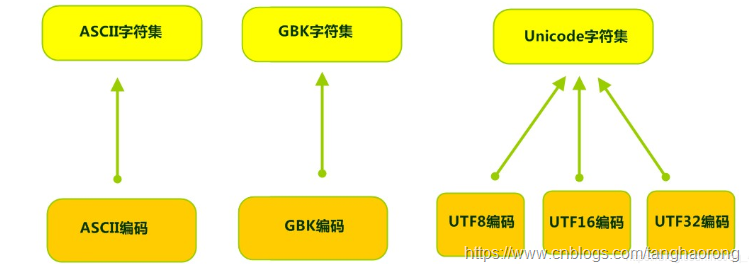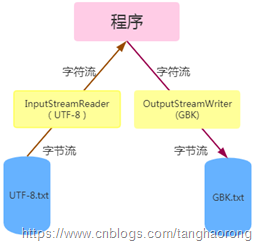转换流也是一种处理流,它提供了字节流和字符流之间的转换。在Java IO流中提供了两个转换流:InputStreamReader 和 OutputStreamWriter,这两个类都属于字符流。其中InputStreamReader将字节输入流转为字符输入流,继承自Reader。OutputStreamWriter是将字符输出流转为字节输出流,继承自Writer。
众所周知,计算机中存储的数据都是二进制的数字,我们在电脑屏幕上看到的文字信息是将二进制转换之后显示的,两者之间存在编码与解码的过程,其互相转换必须遵循某种规则,即编码和解码都遵循同一种规则才能将文字信息正常显示,如果编码跟解码使用了不同的规则,就会出现乱码的情况。
编码:字符、字符串(能看懂的)--字节(看不懂的)
解码:字节(看不懂的)-->字符、字符串(能看懂的)
上面说的编码与解码的过程需要遵循某种规则,这种规则就是不同的字符编码。我们在刚刚学习编程的时候最早接触就是ASCII码,它主要是用来显示英文和一些符号,到后面还有接触到别的编码规则常用的有:gb2312,gbk,utf-8等。它们分别属于不同的编码集。
我们需要明确的是字符编码和字符集是两个不同层面的概念。
encoding是charset encoding的简写,即字符集编码,简称编码。
charset是character set的简写,即字符集。
编码是依赖于字符集的,一个字符集可以有多个编码实现,就像代码中的接口实现依赖于接口一样。

转换流的原理是:字符流=字节流+编码表。在转换流中选择正确的编码非常的重要,因为指定了编码,它所对应的字符集自然就指定了,否则很容易出现乱码,所以编码才是我们最终要关心的。
转换流的特点:其是字符流和字节流之间的桥梁。
可对读取到的字节数据经过指定编码转换成字符
可对读取到的字符数据经过指定编码转换成字节
那么何时使用转换流?
当字节和字符之间有转换动作时
流操作的数据需要编码或解码时

1、InputStreamReader
InputStreamReader是字节流到字符流的桥梁:它读取字节,并使用指定的字符集将其解码为字符。它的字符集可以由名称指定,也可以接受平台的默认字符集。
构造方法:
· InputStreamReader(InputStream in):创建一个默认字符集字符输入流。
· InputStreamReader(InputStream in, String charsetName):创建一个指定字符集的字符流。
构造方法示例代码:
InputStreamReader isr1 = new InputStreamReader(new FileInputStream("D:\IO\utf8.txt")); InputStreamReader isr2 = new InputStreamReader(new FileInputStream("D:\IO\utf8.txt"),"UTF-8");
InputStreamReader读入不同编码举例(读入的文件编码是UTF-8):
package com.thr; import java.io.*; /** * @author Administrator * @date 2020-02-27 * @desc InputStreamReader */ public class InputStreamReaderTest { public static void main(String[] args) { //定义转换流 InputStreamReader isr = null; InputStreamReader isr1 = null; try { //创建流对象,默认编码方式 isr = new InputStreamReader(new FileInputStream("D:\IO\utf8.txt")); //创建流对象,指定GBK编码 isr1 = new InputStreamReader(new FileInputStream("D:\IO\utf8.txt"),"GBK"); //默认方式打印 int len; char[] buffer = new char[1024]; while ((len=isr.read(buffer))!=-1){ System.out.println(new String(buffer,0,len)); } //GBK编码方式打印 int len1; char[] buffer1 = new char[1024]; while ((len1=isr1.read(buffer1))!=-1){ System.out.println(new String(buffer1,0,len1)); } System.out.println("成功..."); } catch (IOException e) { e.printStackTrace(); } finally { //释放资源,先使用的后关闭 if (isr1!=null){ try { isr1.close(); } catch (IOException e) { e.printStackTrace(); } } if (isr!=null){ try { isr.close(); } catch (IOException e) { e.printStackTrace(); } } } } } //运行结果: --UTF-8 武汉加油 中国加油 齐心协力 战胜疫情 --GBK 锘挎�姹夊姞娌� 涓�浗鍔犳补 榻愬績鍗忓姏 鎴樿儨鐤�儏
可以发现,UTF-8编码没有出现乱码,而GBK编码出现了乱码,这是因为是在IDEA编辑器下打印的,我的IDEA编辑器设置的默认编码是UTF-8。而UTF-8的编码集是Unicode,GBK的编码集是GBK,两者并没有通过转换,所以GBK编码在Unicode集上打印出现了乱码。
2、OutputStreamWriter
OutputStreamWriter是字符流通向字节流的桥梁:用指定的字符集将字符编码为字节。它的字符集可以由名称指定,也可以接受平台的默认字符集。
构造方法:
OutputStreamWriter(OutputStream in): 创建一个使用默认字符集的字符流。
OutputStreamWriter(OutputStream in, String charsetName): 创建一个指定字符集的字符流。
构造方法示例代码:
OutputStreamWriter isr1 = new OutputStreamWriter(new FileOutputStream("D:\IO\gbk.txt"")); OutputStreamWriter isr2 = new OutputStreamWriter(new FileOutputStream("D:\IO\gbk1.txt") , "GBK");
OutputStreamWriter读出不同编码举例:
package com.thr; import java.io.*; /** * @author Administrator * @date 2020-02-27 * @desc OutputStreamWriter */ public class OutputStreamReaderTest { public static void main(String[] args) { //定义转换流 OutputStreamWriter osw = null; OutputStreamWriter osw1 = null; try { osw = new OutputStreamWriter(new FileOutputStream("D:\IO\gbk.txt")); osw1 = new OutputStreamWriter(new FileOutputStream("D:\IO\gbk1.txt"),"GBK"); //以默认格式写出 osw.write("武汉加油,中国加油"); //以GBK格式写出 osw1.write("武汉加油,中国加油"); System.out.println("成功..."); } catch (IOException e) { e.printStackTrace(); } finally { //释放资源,先使用的后关闭 if (osw1!=null){ try { osw1.close(); } catch (IOException e) { e.printStackTrace(); } } if (osw!=null){ try { osw.close(); } catch (IOException e) { e.printStackTrace(); } } } } }
我们运行完后发现并没有乱码,这是因为Windows系统默认支持了UTF-8和GBK字符集。可以将输出的路径改为当前项目下 new FileOutputStream(“gbk.txt”);然后用Idea打开就可以看成差别来了。
3、转换文件编码
将UTF-8编码的文本文件,转换为GBK编码的文本文件。
1、指定UTF-8编码的转换流,读取文本文件。
2、使用GBK编码的转换流,写出文本文件。

package com.thr; import java.io.*; /** * @author Administrator * @date 2020-02-27 * @desc 将读入UTF-8文件转换为GBK */ public class ConversionStreamTest { public static void main(String[] args) { //定义转换流 InputStreamReader isr = null; OutputStreamWriter osw = null; try { //创建流对象,指定GBK编码 isr = new InputStreamReader(new FileInputStream("D:\IO\utf8.txt"),"UTF-8"); osw = new OutputStreamWriter(new FileOutputStream("gbk.txt"),"GBK"); int len; char[] buffer = new char[1024]; while ((len=isr.read(buffer))!=-1){ osw.write(buffer,0,len); } System.out.println("成功..."); } catch (FileNotFoundException e) { e.printStackTrace(); } catch (IOException e) { e.printStackTrace(); } finally { //释放资源 if (osw!=null){ try { osw.close(); } catch (IOException e) { e.printStackTrace(); } } if (isr!=null){ try { isr.close(); } catch (IOException e) { e.printStackTrace(); } } } } }